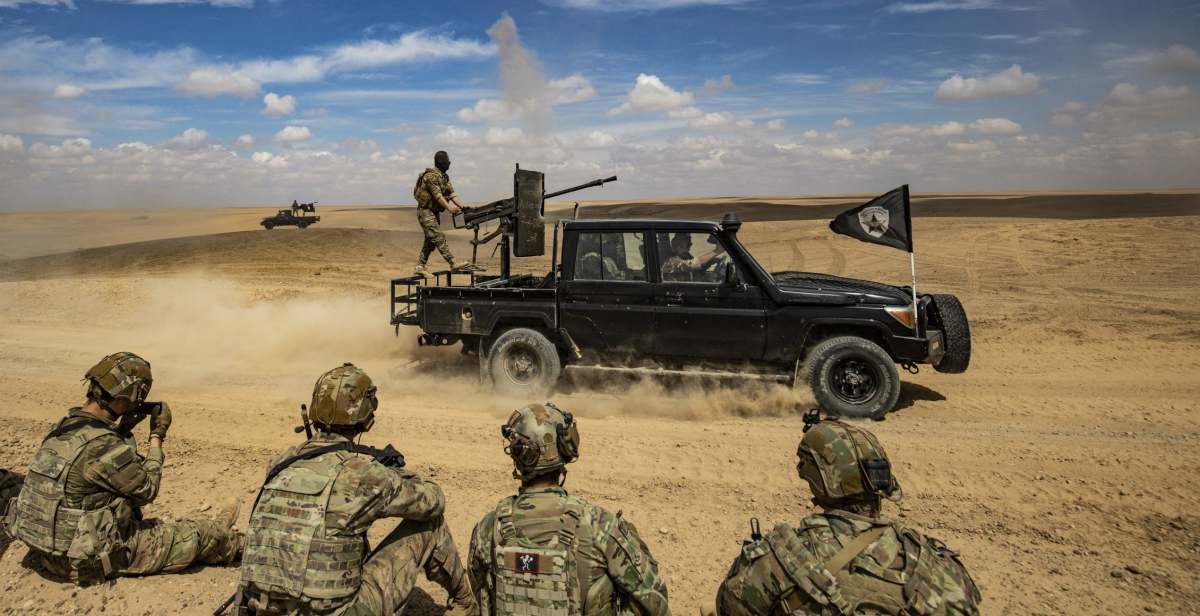The ISIS “Invisible State” in Syria’s Badiyah Desert
By Dr. Tariq Hemo
The ISIS terrorist organization continues to expand in the Syrian Badiyah Desert region, adopting the method of rapid surprise strikes that leave as many casualties as possible, whether military or civilian. The group uses a strategy of intimidation and terror to disrupt the ranks of its opponents and demonstrate the strong presence of an organization whose imaginary state was eliminated and its last stronghold destroyed in 2019 by the Syrian Democratic Forces (SDF).
Currently, the group hides in small groups within the ravines and valleys of the desert, while it continues to build its armed cells in the metropolises and cities of the region of northern and eastern Syria. It also focuses on covert intelligence activity, as is its habit of infiltrating the ranks of its enemies and lurking behind their front lines by planting sleeper cells so it can kill whenever it chooses.
ISIS focuses its operations and attacks primarily on Syrian regime forces in the Badiyah Desert, targeting military posts and passing convoys while not hesitating to harm civilians, whom it alleges are collaborating with the government and its security and military apparatus. Occasionally, the group carries out mass massacres against the local population. Nevertheless, the Syrian Democratic Forces (SDF) remain ISIS’s primary target, as the group conducts planned operations against them. This occurs especially in the eastern Deir Ezzor countryside, where ISIS elements take advantage of the activities of regime-affiliated militias and Iranian forces, using their movements against the SDF as cover, as well as within the cities and urban areas of northern and eastern Syria, where sleeper cells are strategically organized and select their targets with care.
On June 22, the Syrian Observatory for Human Rights released a report on its website, detailing 135 operations conducted by ISIS cells in self-administration areas since the beginning of 2024 (114 in Deir Ezzor, 13 in Hasakah, and 8 in Raqqa). These operations, which included armed attacks, targeted assaults, and bombings, resulted in the deaths of numerous civilians and military personnel.
The organization is establishing a network across vast areas of the Syrian Badiyah (4,000 square kilometers) controlled by the Syrian regime. This web of death encompasses Jabal Abu Rajmin in northeastern Palmyra, the Deir Ezzor Badiyah and its western countryside, and the Sukhna Badiyah north of Suwayda province’s administrative limits. ISIS intends to turn this enormous geographical area into an undeclared state in which its cells have the upper hand, killing any soldier or civilian who goes through. The gang regularly records mass killings and executions and broadcasts them on its websites to chronicle its gruesome presence in the Syrian scene and prove to its fans and fighters that it is still present and strong.
In its conflict with the SDF, ISIS clearly benefits from attacks by local militias supported by Damascus and Tehran on SDF bases and personnel in Deir Ezzor province. These militias usually attribute ISIS attacks (particularly suicide attacks) to themselves. Pro-militia pages on social media share news and footage of these attacks as operations against the SDF.

ISIS also takes utilizes Turkish drone attacks and infrastructure targeting in northern and eastern Syria. It takes advantage of the military and security focus on the Turkish assaults to infiltrate and breach security measures, carrying out bombings, assassinations, and sabotage operations against SDF headquarters and people, particularly in Deir Ezzor and Raqqa. Notably, ISIS boosts its operations in direct response to every Turkish military attack on Self-Administration territories.
ISIS continues to use areas under Turkish occupation and control by Hay’at Tahrir al-Sham or HTS (formerly Jabhat al-Nusra) as a rear base and safe haven for its senior leaders and officers. A look at the list of ISIS leaders and officials slain by US troops in Syria demonstrates how much the organization relies on Turkish-occupied territory and Hay’at Tahrir al-Sham as a safe haven for hiding, planning, and resource security. On June 16, last year, US forces confirmed the death of Osama Ibrahim Al-Janabi, one of ISIS’s top leaders in Syria, after a military operation.
On 27 October 2019, US forces killed the group’s first leader and founder/caliph of the so-called caliphate, Abu Bakr al-Baghdadi, in an area in rural Idlib. Abu Ibrahim al-Qurashi, the organization’s second leader, was slain on February 3, 2022, in a rural Idlib area. In early May 2023, the fourth leader of the organization, Abu al-Hassan al-Husseini al-Qurashi, was killed in an area in rural Aleppo.
These strikes are in addition to US forces targeting the organization’s leaders (the organization’s Shura Council) in northwestern Syria, such as Abu Sara al-Iraqi, who was killed in the village of Mashhad Ruhin in the northern countryside of Idlib, and the former spokesmen of the organization, Abu al-Hassan and Abu Hamza, who were killed in Jarablus, Abu Saad al-Shamali, the organization’s official in Syria, was killed in the al-Bab area, while Abu Bakr al-Gharib was killed in Turkish-occupied Afrin. In July 2023, the United States reported that it had assassinated Maher al-Akkal, the commander of ISIS in Syria, with a drone attack. The US military stated in February 2023 that Hamza al-Homsi had been killed.
These attacks on senior ISIS leaders suggest an understanding and collaboration between ISIS and both Turkish and Hayat Tahrir al-Sham authorities that ISIS leaders will use Turkish occupation areas and Idlib as safe havens, possibly in exchange for intensifying their destructive operations against the Autonomous Administration areas and the Syrian Democratic Forces (SDF).
The organization still has great capability to attack and commit massacres. Its latency period, which can last for months, indicates that it is planning and preparing for an attack or surprise. ISIS employs shock and awe tactics. It employs as much violence and ferocity as possible. Taking advantage of, and relying on, the area of influence in the Syrian Badiyah, or the ‘underground state’, the presence of leaders and large cadres with planning and financial resources in the areas of Turkish occupation, and the influence of the al-Qaeda affiliate Hay’at Tahrir al-Sham, the organization will target every area or sector it perceives as ‘soft’ or a weak point it can exploit. Therefore, it is critical for the SDF and ISF to secure ‘soft’ sectors, such as refugee camps, jails, and crucial facilities.
There is no doubt that ISIS wishes to carry out a major operation in which it kills hundreds or thousands of people (such as the Kobane massacre on June 25, 2015, in which hundreds of Kurdish civilians, mostly women and children, were killed), in order to announce a ‘strong return’ to the scene and provide its supporters in the region and around the world with great motivation and morale. Therefore, greater protection is needed for the refugee camps housing displaced people from Afrin and Serê Kaniyê (Ras al-Ayn), along with securing the entrances and exits in and out of north and east Syria. This is especially true in the event of Turkish drone attacks, which may coincide with special operations carried out by ISIS, which the last ten years show are merely a tool used by the Turkish state against the Kurdish people in Syria, Iraq, and Turkey.




Comments are closed.